Electrical noise consists of random, unpredictable signals that interfere with the desired electrical signal, while harmonic distortion arises from consistent, unwanted frequencies generated within a system, altering the original waveform. Understanding the difference between these two can help you improve signal clarity and system performance; explore the rest of the article for deeper insights.
Table of Comparison
| Attribute | Electrical Noise | Harmonic Distortion |
|---|---|---|
| Definition | Unwanted random electrical signals superimposed on useful signals. | Distortion caused by integer multiples of fundamental frequency signals. |
| Source | Thermal fluctuations, electromagnetic interference, and environmental factors. | Non-linear loads, power electronic devices, and switching equipment. |
| Frequency Characteristics | Broadband and random frequency spectrum. | Discrete frequencies at harmonics (multiples) of the fundamental frequency. |
| Effect on Signals | Decreases signal-to-noise ratio; causes data errors and poor signal quality. | Alters waveform shape; leads to inefficiency and potential equipment damage. |
| Measurement | Signal-to-noise ratio (SNR), noise figure. | Total Harmonic Distortion (THD), individual harmonic amplitudes. |
| Mitigation | Shielding, filtering, grounding, and noise reduction techniques. | Use of harmonic filters, proper equipment design, and load management. |
| Common Applications | Audio systems, communication channels, precision measurement instruments. | Power systems, industrial electronics, audio amplifiers. |
Understanding Electrical Noise: Definition and Sources
Electrical noise refers to unwanted random signals that interfere with the desired electrical signal, typically caused by thermal agitation, electromagnetic interference, or switching devices. Common sources of electrical noise include power lines, radio frequency interference, and electronic component imperfections. Differentiating electrical noise from harmonic distortion is essential, as noise alters signal clarity, whereas harmonic distortion introduces systematic frequency components related to the original signal.
What is Harmonic Distortion? Key Concepts Explained
Harmonic distortion refers to the alteration of a signal's waveform caused by harmonics--integer multiples of a fundamental frequency--introduced primarily by nonlinear devices or components in electrical systems. It results in the presence of unwanted frequencies that degrade signal quality, impacting audio clarity, power signal integrity, and overall system performance. Unlike electrical noise, which is random and broadband, harmonic distortion is deterministic and frequency-specific, making its identification and mitigation crucial for high-fidelity audio systems and precision electronic equipment.
Comparing Electrical Noise and Harmonic Distortion
Electrical noise refers to random, unpredictable fluctuations in an electrical signal caused by external interference or internal circuit components, while harmonic distortion involves specific frequency components at multiples of the fundamental frequency, generated by nonlinear system behavior. Noise typically lowers the signal-to-noise ratio and degrades signal clarity, whereas harmonic distortion alters the waveform shape leading to signal distortion and potential equipment malfunction. Measuring total harmonic distortion (THD) and noise spectral density helps in quantifying and differentiating their impact on electrical systems.
Causes of Electrical Noise in Power Systems
Electrical noise in power systems primarily originates from electromagnetic interference (EMI), switching operations, and faulty insulation in electrical equipment. Sources such as lightning strikes, switching transients from transformers, and switching of capacitors generate high-frequency noise that disrupts signal integrity. Understanding these causes helps you implement effective noise mitigation techniques to protect sensitive power system devices.
Common Sources of Harmonic Distortion
Common sources of harmonic distortion in electrical systems include nonlinear loads such as variable frequency drives, fluorescent lighting, and power electronic devices. These components cause current waveform distortion by drawing non-sinusoidal currents, leading to voltage waveform distortion in power systems. Transformers and capacitors can also contribute by interacting with the distorted currents, amplifying harmonic levels and impacting overall power quality.
Effects of Electrical Noise on Equipment Performance
Electrical noise causes signal interference and data corruption, leading to reduced accuracy and reliability in electronic equipment performance. It can induce erratic behavior, signal degradation, and increased error rates in communication systems and control devices. Prolonged exposure to electrical noise accelerates wear and failure of sensitive components, impacting overall operational stability.
Impact of Harmonic Distortion on Power Quality
Harmonic distortion significantly degrades power quality by causing voltage and current waveform deviations from their ideal sinusoidal shapes. These distortions lead to increased losses in electrical equipment, overheating, and malfunctions in sensitive devices, reducing system efficiency and reliability. Monitoring and mitigating harmonic distortion is essential to ensure consistent power quality and protect the integrity of electrical infrastructure.
Detection and Measurement Techniques
Electrical noise is primarily detected using spectrum analyzers and oscilloscopes equipped with fast Fourier transform (FFT) capabilities to identify broadband and transient disturbances, whereas harmonic distortion is measured by harmonic analyzers and power quality meters designed to quantify specific frequency components relative to the fundamental signal. Techniques such as total harmonic distortion (THD) calculation and intermodulation distortion analysis enable precise quantification of harmonic content, while noise figure meters evaluate noise levels in amplifiers and RF circuits. Accurate detection and measurement of both phenomena rely on time-domain and frequency-domain methods, ensuring improved signal integrity and system performance in electrical and electronic applications.
Mitigation Strategies: Reducing Noise and Harmonics
Effective mitigation strategies for electrical noise and harmonic distortion include installing passive filters, such as LC and RC networks, which reduce high-frequency noise and harmonic currents in power systems. Active harmonic filters dynamically compensate for distorted waveforms by injecting counteracting currents, improving power quality and protecting sensitive equipment. Proper grounding, shielding, and the use of isolation transformers further minimize interference and maintain system reliability.
Real-World Applications and Best Practices
Electrical noise and harmonic distortion significantly impact the performance of sensitive electronic systems in real-world applications such as telecommunications, audio engineering, and power distribution. Effective mitigation practices include employing proper shielding, using low-noise components, implementing active filtering techniques, and maintaining stringent grounding standards to minimize electromagnetic interference and waveform distortion. Adhering to these best practices enhances signal integrity, reduces system downtime, and ensures compliance with industry standards like IEEE 519 for power quality.
Electrical Noise vs Harmonic Distortion Infographic

 electrown.com
electrown.com